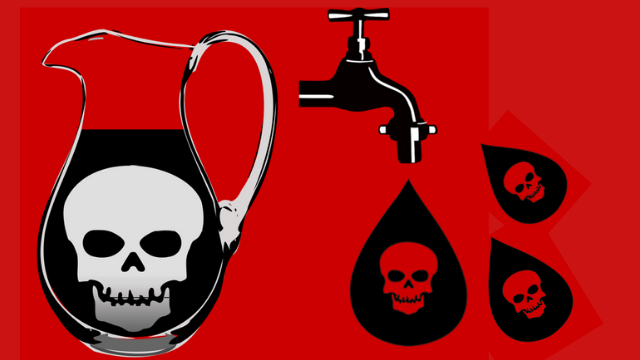We are today more than ever before, subjected to more toxic elements than any of our ancestors had ever encountered. In every aspect of life we are subjected to these toxins.
About 400 synthetic chemicals can be found in the average human body. Since World War II, 100,000 new synthetic chemicals have been released into the environment.
Astonishingly less than half of these have been tested for potential toxicity to adult humans. This leaves a lot of unanswered questions and concern about the safety of these substances.
With the lack of health data on these chemicals it makes sense to be proactive about limiting our chemical exposure.
Toxins are everywhere in the environment and accumulate in the body tissues, therefore anyone could have a level of toxic substances in their body that causes harm.
If you work in an industry that involves the use of chemicals, or have a history of exposure to harmful chemicals, you may have an increased toxic load in the body.
Today we are challenged with increased incidences of lifestyle disease such arthritis, cardiovascular disease, diabetes, endometriosis, inflammatory diseases, immune disorders, osteoarthritis, osteoporosis, stress related illnesses depression and cancer.
Heavy metals such as mercury, lead, cadmium, and aluminium, are in our food, water, and atmosphere. Herbicides, pesticides, fungicides, hormones and antibiotics, are found in the food supply chain we eat unless you eat organic.
Modern agriculture is more resource intensive than ever before, very fossil fuel dependent, using fertilisers, and based on massive production. Today food is grown in depleted soil with artificial chemicals.
Foods now commonly have low level of nutrients such as minerals, vitamins and antioxidants. These already compromised foods are further refined and adulterated.
Chemicals enter the food supply through intentional and unintentional sources. Unintentional sources include pesticides, heavy metals, antibiotics, growth promoting substances such as hormones.
Evidence has been steadily accumulating that certain hormone-mimicking pollutants are ubiquitous in the food chain.
Intentional sources include over 10,000 food and chemical additives allowed in the food supply. These additives come as colourings, sweeteners, stimulants, preservatives, flavourings, emulsifiers, and humectants.
Toxins can concentrate in the food chain and expose us to a greater concentration of certain environmental toxins than those that are studied.
Processed foods are commonly consumed today, a change from a generation ago. These same highly processed foods tend to be of poor quality with many of the essential nutrients destroyed in the process, thus providing little nutritional value.
They also tend to be full of problematic additives such as salt, sugar, corn syrup, saturated or Trans fats, preservatives, food additives (such as MSG or aspartame), and other chemicals.
However when consuming these foods the body still needs those now missing nutrients to digest and break it down and since they are absent, the refined food leaches nutrients from the body’s stores, worsening the situation.
So what can you do to lessen the toxic load in food?
Buy organic, especially the dirty dozen as stated by the Environmental Working Group, apples, peaches, nectarines, strawberries, grapes, celery, spinach, capsicum, cucumbers, snap peas, cherry tomatoes, and potatoes.
Avoid GMO products.
Wash, scrub or peel fruits and vegetables.
Avoid processed foods.
Read labels and avoid buying processed food products containing corn, soy, canola, and vegetable oil.
Trim fat from meat as pesticides are generally fat soluble.
Grow your own vegetables.
Use unbleached paper products.
Store food in glass containers.
Our bodies are further challenged by environmental pollution and stressful lifestyles. From water to the containers the water and food is delivered to us to the personal hygiene products and the cleaning products contain toxins.
Water Toxins
Water today is contaminated with heavy metals, pesticides, herbicides, fluoride, quantities of drugs, antibiotics, hormones, and industrial waste, to name a few.
So what can you do to lessen the toxic load in water?
Filter water.
Use glass bottles for water.
Avoid plastic bottles.
Indoor Air Toxins
Today more than ever people spend more times indoors. Sources of air indoor toxins include: cleaning products, furniture, cabinets, and panelling. Wall to wall carpets, dry cleaning, mattresses, mould and pesticides
Some of the main chemical classes found indoors are:
Phthalates; these chemicals are plasticizers used to make plastic more flexible and resistant. They are found in PVC, plastic softeners, wall coverings, raincoats, shower curtains, plastic wrap, and food containers.
Phthalates have been shown in studies to cause endocrine disruption in men, and some types are suspected carcinogens.
Phenols found in disinfectants, detergents and adhesives are considered a suspected carcinogen.
Polybrominated diphenyl ethers are used as flame retardants. They are used for plastic in TV’s and computer monitors. They can be toxic at low levels and are persistent in the environment. PBDE’s may affect learning, behaviour, memory and hormone systems.
So what can you do to lessen the toxic load in indoor air toxins?
Open windows once a day to circulate fresh air in the home.
Research the ingredients in the products used in the home.
Use upholstery and drapes products made with natural foam and natural fibres.
Buy vintage or salvage furniture to avoid new product off gassing.
Use natural floor boards that are not treated with toxic chemicals such as arsenic.
Use a quality vacuum cleaner.
Test the home for mould.
Use indoor plants, not only are they beneficial for increasing oxygen levels in homes, they have also been found to reduce the toxins in the air. NASA have found that plants and the microbes at their roots can, through their normal photosynthesis process, absorb these pollutants and provide the fresh air plants such as Peace Lily (Spathiphyllum “Mauna Loa L.); Rubber Plant (Ficus robusta L.); Bamboo palm (Chamaedorea seifrizii L.); Lady Palm (Rhapis excels L.) Areca Palm (Chrysalidocarpus lutescens L.)and Moth Orchids (Phalaenopsis sanderana L.)
Dry clean less, and air dry cleaned garments out of the plastic before wearing.
Cleaning Product Toxins
Daily we are exposed to toxic cleaning products and their residues. When these chemicals are used to clean the home, they linger in the air and are breathed in.
These toxins also enter the body by absorption through the skin or through ingestion of household dust and chemical residues left on dishes and cutlery.
A generation ago our granny’s cleaned the house with ingredients like vinegar, baking soda, bees wax and essential oils.
Today chemicals in cleaning products contain phthalates and can be found in synthetic fragrances of household products, such as air fresheners, dish soap, even toilet paper.
Some cleaning products have the word like ‘poison’, ‘corrosive’ or ‘irritant’, ‘hazardous to humans and domestic animals’ why use them?
Bleach fumes consist of a complex mixture of toxic, carcinogenic and irritating gases, including chlorine, chloroform and carbon tetrachloride. Chlorine bleach has been linked to respiratory damage and wheezing as well as nose and eye irritation.
The active ingredient in antibacterial soap is triclosan, which is linked to liver toxicity and, at low levels, may disrupt thyroid function.
Ingredients in common household products have been linked to asthma, allergies, cancer, reproductive disorders, hormone disruption and neurotoxicity.
So what can you do to lessen the toxic load in cleaning products?
Make your own cleaning products.
Read labels if you see the word ‘fragrance’ on a label, there’s a high probability that phthalates are present. Use natural options such as organic essential oils.
Personal Hygiene Product Toxins
Personal hygiene, body-care products and makeup are also a hot bed of toxins. From toothpaste, deodorant, hair dyes shampoos, conditioners, lotion, and perfumes.
Toxic synthetic chemicals are the biggest issue in the beauty industry today, found in cosmetics, skin care products, perfumes and personal hygiene products including toothpaste.
All this before we even look at drugs and alcohol. Heavy metals such Mercury (found in many people’s dental fillings and in some vaccines as a preservative) and other heavy metals can compromise immune response over time.
Perfume is full of phthalates and synthetic chemicals.
So what can you do to lessen the toxic load in personal hygiene products?
- Understand your personal toxic load by testing for heavy metals.
- Make your own skin care products or buy a natural skin range.
- Remove amalgam fillings.
- Read labels if the words ‘fragrance’ and ‘parfum’ appear in the ingredients list of personal hygiene or cleaning products do not purchase it.
In summary the human physiology, biochemistry, pathology and anatomy are intricately interwoven. Change is possible; a start to wellness is to eliminate as many toxins from the food supply, the body and from the home environment.
Buy whole foods instead of processed food, the added bonus are it is much cheaper generally to make things yourself than to buy processed, packaged and manufactured foods. Be mindful of the ingredients in cleaning and personal hygiene products.
Eliminate all toxins from your life and your body will ensure a healthier future.
You can find much more information on living a holistic lifestyle in these free magazines and on our YouTube channel.

Irene Vervliet – Naturopathic Doctor
References
David Suzuki, http://www.davidsuzuki.org/issues/health/science/toxics/the-dirt-on-toxic-chemicals-in-household-cleaning-products/
Environmental Working Group’s chemical index at http://www.ewg.org/chemindex
Environmental working group at http://www.ewg.org/foodnews/dirty_dozen_list.php
Environmental working group, http://www.ewg.org/foodnews/summary.php
EPA, http://www.epa.gov/ttnatw01/hlthef/phenol.html
Green seal http://www.greenseal.org
Green guard, http://www.greenguard.org/ certification
How to Grow Fresh Air: 50 House Plants that Purify Your Home or Office (Penguin; First Edition edition April 1, 1997).
Huffington Post http://www.huffingtonpost.com/samuel-s-epstein/toxic-chemicals_b_625648.html
Mercola, http://fluoride.mercola.com
Mercola, http://articles.mercola.com/sites/articles/archive/2013/11/27/toxic-perfume-chemicals.aspx
Natural news, http://www.naturalnews.com/035495_water_filters_health_distilled.html
National Institute of Health, http://householdproducts.nlm.nih.gov/
National Institute of Health, http://hpd.nlm.nih.gov/cgi-bin/household/prodtree?prodcat=Personal+Care
NASA, http://ntrs.nasa.gov/archive/nasa/casi.ntrs.nasa.gov/19930073077.pdf
Wolverton Environmental Services (http://www.wolvertonenvironmental.com/air.htm), Last updated May 2009.
Health impact News, Is Your Health Being Destroyed by Other People’s Toxic Fragrances? “http://healthimpactnews.com/2014/secondhand-fragrance-contamination-a-public-health-problem/#sthash.eO5qCUQb.MjP0eE3S.dpuf”
Health impact News, http://healthimpactnews.com/2014/secondhand-fragrance-contamination-a-public-health-problem/
http://www.aabri.com/manuscripts/09244.pdf






